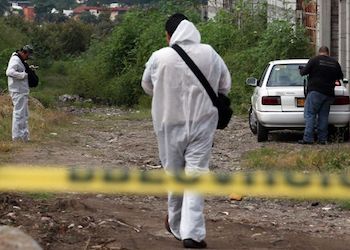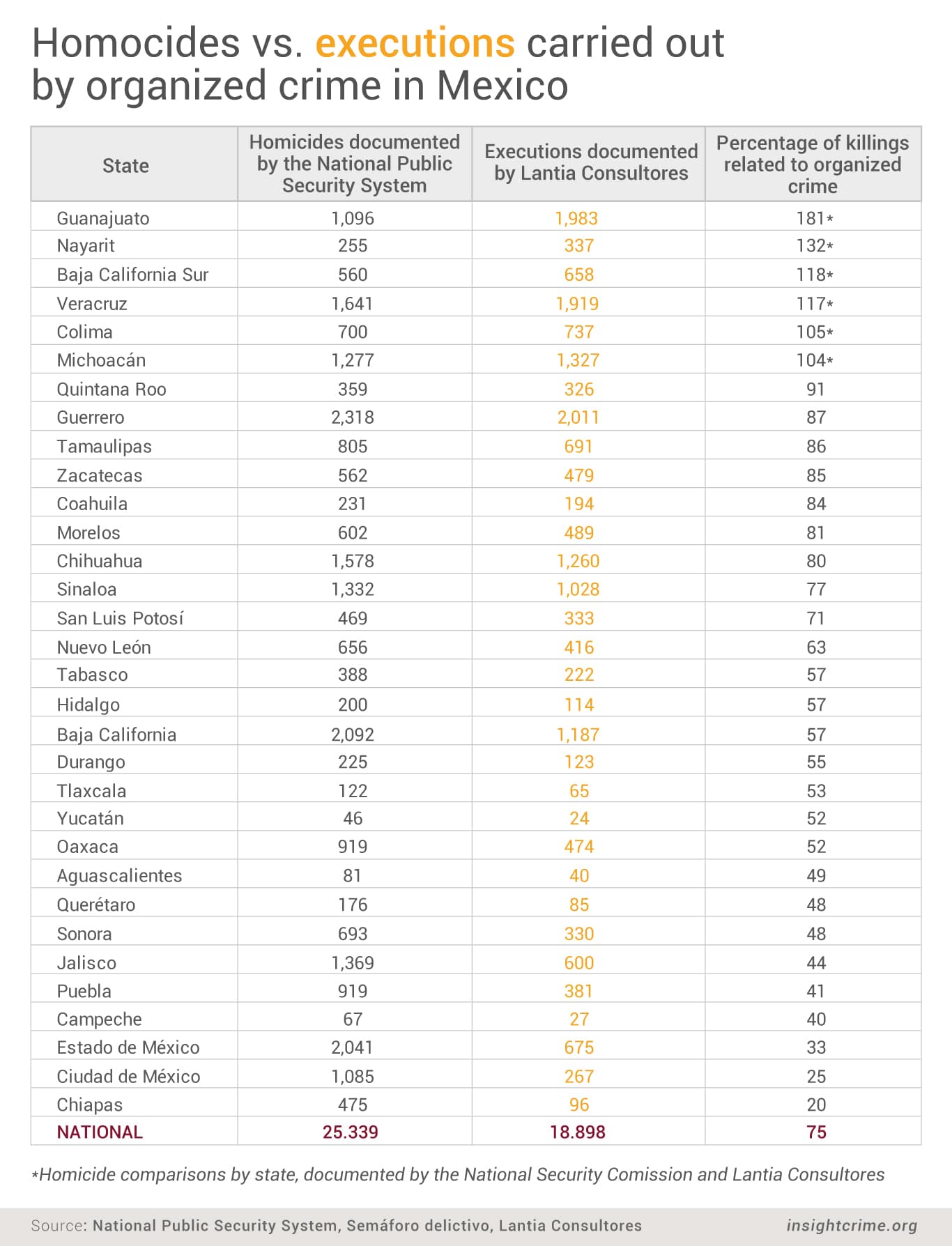Organized crime-related homicides reached a record high in Mexico in 2017, according to a recent study which compares government statistics with documented executions carried out by criminal groups, depicting the country’s bloodiest organized criminal landscape since the beginning of the war on drugs. The increase is believed to be caused by territorial disputes.
Criminal groups carried out 18,898 executions in Mexico in 2017, according to the watchdog agency Semáforo Delictivo and Lantia Consultores.
Lantia Consultores used their own methodology to come up with the final figure, which accounts for cases not included in the official registry of homicides by Mexico’s National Public Security System (Sistema Nacional de Seguridad Pública – SNSP). Organized crime-related homicides in 2017 would have represented 75 percent of the 25,339 total murders recorded by the SNSP throughout the year, if the figures from both sources were equivalent.
Last year’s figures showed a massive increase in the percentage of organized crime-related killings, which only represented 20 percent of total homicides in Mexico in 2006 — the outset of the country’s war on drugs.
Compared to the statistics from 2016, every state in Mexico (with the exception of Sonora, which borders Arizona, and Morelos, located south of Mexico City) saw an increase in the number of executions related to organized crime. The states with the highest number of killings were Guerrero, Guanajuato, Veracruz, Michoacán, Chihuahua and Baja California.
SEE ALSO: Coverage of Homicides
Some places saw a dramatic increase. Organized crime-related homicides in the western state of Nayarit surged from 31 in 2016 to 337 in 2017. Guanajuato also saw a dramatic spike in organized crime-related murders, going from 670 killings in 2016 to 1,983 a year later, making it only second to violence-ridden Guerrero.
The study also shows the percentage of total homicides related to organized crime in each state. Lantia Consultores collected reports and drew upon media coverage to establish the number of killings, and Semáforo Delictivo calculated the percentage of killings in relation to the total number of homicides as reported by the SNSP.
It should be noted that the study shows states with percentages that exceed 100 percent. This is because the government counts homicides on a case-by-case basis, and does not report the number of individual victims killed in each incident. Lantia, on the other hand, counted the total number of victims killed, including those found in mass graves. As a result, Lantia’s count sometimes exceeds the official government count.
When Semáforo Delictivo’s methodology is applied, Guanajuato, Nayarit, Baja California Sur, Veracruz, Colima, Michoacán and Quintana Roo come up as the most violent states, as the number of executions at the hands of criminal groups goes over 90 percent of the total number of homicides (see chart below).
InSight Crime Analysis
In an interview with InSight Crime, Santiago Roel, Director of Semáforo Delictivo, said that making a distinction between organize crime-related homicides and the total number of homicides helps to get a better idea of the actual criminal landscape in Mexico.
“There are some cases, like the state of Aguascalientes, which has the second lowest rate of homicides in the country, but almost all cases are executions carried out by organized crime,” Roel said. “Therefore (this methodology) helps us get a clearer picture of the presence of organized crime. It allows us to know how much of the violence is a direct result of these groups, and how much is caused by something else.”
It’s no surprise that the states with the highest number of executions by organized crime are also those that are most strategically important for the operation of criminal economies, as well as the criminals that operate them.
“Whenever we see a high number of executions, it’s a good indicator of conflict between criminal groups,” Roel said. “For us, the major determining factor is the group’s wish to take control of a territory, whether it’s for growing illegal crops, trafficking, or selling drugs.”
In recent years, Guerrero, which tops the list as the state with the highest number of executions, has transformed from the country’s epicentre of poppy cultivation to a continually disputed territory, a result of the splintering of large cartels like the Beltrán Leyva Organization (OBL) and the Familia Michoacana. The Jalisco Cartel – New Generation (Cartel Jalisco Nueva Generación – CJNG) and self-defense groups like the Viagras also have a strong presence in the state.
Baja California and Chihuahua have been historically important territories for organized crime because of their strategic importance as drug transit corridors to the United States. The Sinaloa, Juárez, and the CJNG cartels are currently reported to be operating in the region.
SEE ALSO: Mexico News and Profiles
The Gulf state of Veracruz has also been caught in the crossfire between criminal groups fighting for access to the Atlantic through control of the state’s numerous ports. The state is also strategically positioned as another drug corridor to the north. The largest collection of mass graves was found in Veracruz in 2017, where authorities recovered at least 260 bodies.
Guanajuato — a recent arrival at the top of the list — was the state that saw the most petroleum theft from Pemex’s oil and gas pipelines. It’s likely that territorial disputes between criminal groups that engage in illegal pipeline tapping play a major role in the dramatic increase in homicides in the state.
It should be noted that states like Quintana Roo, Baja California Sur and Nayarit — some of the most popular tourist destinations in Mexico — have very high rates of killings. InSight Crime has reported that as traditional cartels continue to fragment, local groups that don’t necessarily have clear alliances or loyalty to larger organizations are likely to engage in more violence. Quintana Roo’s tourism industry also creates a fertile market for drug sales, according to Roel.
Because criminal groups will likely to continue to splinter in 2018, Mexico can expect more disputes over strategic plazas, as well as the bloody executions that are part and parcel of the country’s organized crime landscape.


